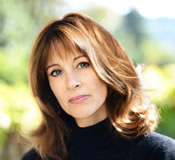
Juliet Gael was raised in the Midwest and obtained her M.A. in French literature before pursuing graduate film studies at USC and English literature at UCLA in Los Angeles, California.
She has lived abroad for more than fifteen years, primarily in Paris, where she worked as a screenwriter. She now makes her home in Florence, Italy.
Juliet is currently at work on a novel about Mary Shelley, author of Frankenstein.
JOIN THE
MAILING LIST!
Keep up to date on Events, Book Club promotions, materials and more..

|
To the Reader ~
Thousands of readers, writers, and scholars have fallen under the Brontë spell, as I first did during a graduate seminar over fifteen years ago. Countless plays, novels, and films have been spun from their lives and their work. But what I found so gripping was the true story of Charlotte’s personal struggle: her determination to overcome circumstance, even her own temperament and nature, in order to taste just a few of life’s splendors, its thrills and beauties; and the irony of how and with whom she became a woman fulfilled.
From the beginning I was committed to as much historical accuracy as the narrative could bear; it was tempting to omit some of the characters who impacted her life, or tighten the progression of her relationship with George Smith, but it would have meant sacrificing a deeper and more complex portrayal. Her accumulated losses, disappointments, and sense of betrayal were instrumental in throwing her into Arthur’s arms. Likewise, the political and social problems of their time needed to be addressed. Arthur’s religious intolerance presented an enormous hurdle to Charlotte personally, and the historical context of their differences needed to be woven into the story.
Nearly all of Charlotte’s letters are her own, with minor editing and only occasional invention, and her letters also provided the substance, if not the language, for some of the dialog. I also turned to her novels for character development, particularly Shirley, where I felt she was speaking, through her characters, of her sisters and their relationship to their father. After countless readings of all the sisters’ works and letters concurrently with biographies and historical documents of the region and the period, I felt confident making those choices.
As a novelist I draw on what may be a minor incident or anecdote to develop the story, some of which were alluded to in biographers’ footnotes, or could be inferred by reading between the lines of correspondence. Necessarily, there was a certain compression of events at the beginning, but even the time-frame of their lives during these years is, for the most part, accurate.
A few of the minor characters, such as Miss Dixon, are pure invention. Arthur Nicholls was an obscure figure about whom very little was known, although Charlotte certainly wrote a good deal about him during the difficult months after his proposal. Even then, the portrait she paints of him was skewed by her own prejudices, and later, when that attitude had been transformed by love, she said little about their intimate lives. Thus it was this part of the story that allowed my imagination the most freedom – although I do not hesitate to add that the progression of their romance accurately follows Charlotte’s account, and nearly all the scenes toward the end were rooted in authentic incidents, particularly the events that led her to view him in a new light, and fall in love with him. Arthur’s letters to Charlotte are my own creation, and, I suspect, given his deep feelings, I have not fallen far from the mark. Intentionally, his outpourings draw from the same language she used in her letters to Heger. I took enormous pleasure in bringing Arthur to life and giving him his due in the story.
This novel would not have been possible twenty-five years ago; it stands on the shoulders – I should say in the shadows – of remarkable scholarly achievements. I am particularly indebted to Juliet Barker’s extensive work, The Brontës, which brought to light difficult-to-access sources such as George Richmond’s papers and George Smith’s autobiography, and to Margaret Smith’s monumental three-volume edition of all Charlotte’s surviving letters. I would also enthusiastically recommend The Brontës: Charlotte Brontë and Her Family by Rebecca Fraser, recently reissued as Charlotte Brontë: A Writer’s Life, Helene Moglen’s Charlotte Brontë: The Self Conceived, and Elizabeth Gaskell’s The Life of Charlotte Brontë. It is my sincere hope that my novel will inspire the reader to pick up one of these fascinating studies. And, of course, the Brontës’ novels as well.
|


